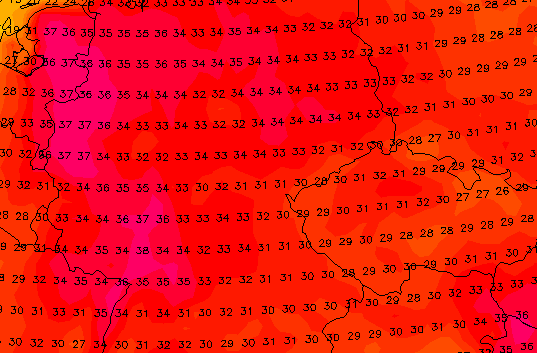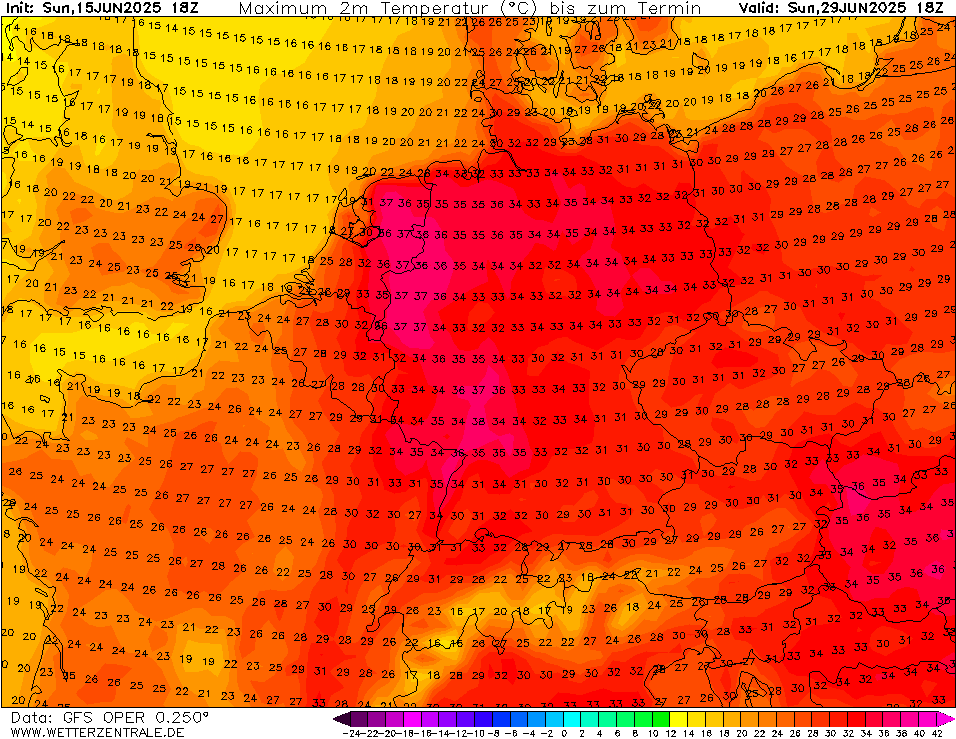
Just days after the first intense wave of heat threatened all-time June temperature records across Western Europe, a second, even more expansive heatwave is forecast to strike in the final days of June 2025. This time, Germany is expected to reach temperatures as high as +38°C, while the Netherlands may again climb to +37°C, matching peaks from earlier this month.
In June, the highest temperature recorded in Germany is 39.2°C (102.6°F) in Cottbus on June 19, 2022.
🔁 Back-to-Back Heatwaves: A Dangerous Pattern
Meteorological agencies across Europe confirm that this late June surge will arrive just one week after the first heatwave, which already pushed several countries toward historic records.
- Germany: Forecasts show broad areas, particularly in the west and south (such as North Rhine-Westphalia, Hesse, and Bavaria), could exceed 38°C between June 27 and 30.
- Netherlands: The southeast — including Limburg and parts of Brabant — may see a repeat of +37°C, with prolonged daytime heat and uncomfortable, tropical nights.
Such repetition not only amplifies health and infrastructure risks, but also demonstrates the increasing persistence of high-pressure systems under global warming conditions.
🌍 Why This Second Heatwave Is Even More Worrisome
Unlike the first wave — fueled by Saharan air masses — this second event is expected to evolve more slowly, building heat over several days under stagnant high pressure. This raises the risk of:
- Cumulative heat stress on vulnerable populations
- Crop damage, especially in areas already facing soil dryness
- Overloaded energy systems due to continued high demand for cooling
- Greater risk of wildfires, especially in dry forests and grasslands
According to experts at Germany’s DWD (Deutscher Wetterdienst) and the Dutch KNMI, late June 2025 could rival or exceed previous late-June heat events, such as the notorious 2019 and 2015 heatwaves.
🏘️ Urban Areas at High Risk
Major cities such as Frankfurt, Cologne, Munich, and Amsterdam may face significant challenges:
- Public transport disruption (track deformation, power issues)
- Overheated homes and schools with little or no air conditioning
- Increased emergency service calls, especially for the elderly
- Lower worker productivity and school attendance due to heat exhaustion
Urban heat island effects will make nighttime relief elusive — with minimum temperatures staying above 22–25°C in cities, further increasing health risks.
📉 A Climate Feedback Loop Unfolding
Two consecutive heatwaves in one month across Central and Western Europe reflect not just random variability, but a deepening climate trend. Scientists note that:
- The jet stream is becoming weaker and more meandering, allowing heat domes to persist longer.
- Warmer baseline temperatures mean that every weather pattern sits atop a hotter foundation, increasing extremes.
- Soils are drier due to reduced spring rains, which amplifies heat by reducing surface evaporation — a phenomenon called “compound drought-heat feedback.”
In simple terms, Europe’s climate is not just getting warmer — it’s getting more volatile and more punishing.
🗓️ Forecast Timeline: June 27–30
This second wave is expected to build slowly starting June 25, peaking June 27–30. High-pressure systems over Central Europe will trap hot air and prevent meaningful cooling, particularly over Germany and the Netherlands.
Meteorologists suggest peak temperatures could again challenge all-time national June records — even though those records were nearly broken just days earlier.
🧭 Final Thoughts: A New Normal Arrives Early
Two heatwaves in one month. Temperatures pushing near or beyond 38°C in both Germany and the Netherlands. What was once exceptional is now becoming alarmingly frequent.
This late-June heatwave is a reminder: climate disruption is no longer a future concern — it’s here, recurring, and intensifying. And Europe’s infrastructure, agriculture, and public health systems must catch up — fast.
Stay alert, stay safe, and prepare for more than just one heatwave each summer. The pattern is changing — and the stakes are rising.


Detail.


























